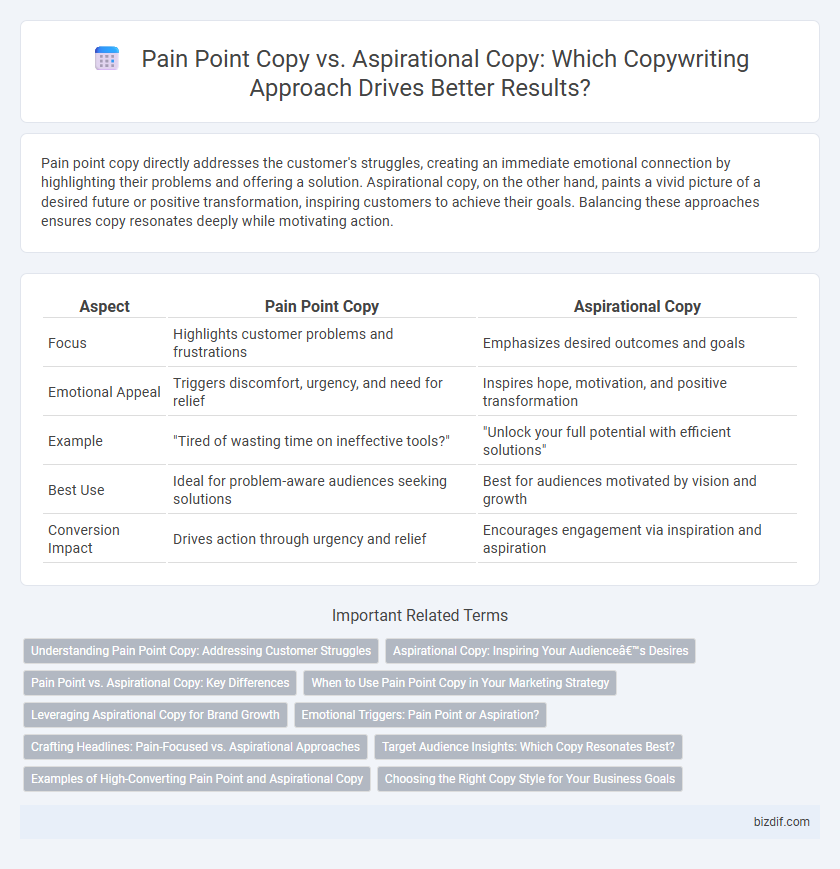Pain point copy directly addresses the customer's struggles, creating an immediate emotional connection by highlighting their problems and offering a solution. Aspirational copy, on the other hand, paints a vivid picture of a desired future or positive transformation, inspiring customers to achieve their goals. Balancing these approaches ensures copy resonates deeply while motivating action.
Table of Comparison
| Aspect | Pain Point Copy | Aspirational Copy |
|---|---|---|
| Focus | Highlights customer problems and frustrations | Emphasizes desired outcomes and goals |
| Emotional Appeal | Triggers discomfort, urgency, and need for relief | Inspires hope, motivation, and positive transformation |
| Example | "Tired of wasting time on ineffective tools?" | "Unlock your full potential with efficient solutions" |
| Best Use | Ideal for problem-aware audiences seeking solutions | Best for audiences motivated by vision and growth |
| Conversion Impact | Drives action through urgency and relief | Encourages engagement via inspiration and aspiration |
Understanding Pain Point Copy: Addressing Customer Struggles
Pain point copy targets the specific challenges and frustrations customers face, using empathetic language to resonate deeply with their struggles. It highlights problems such as wasted time, high costs, or inefficient processes, creating a sense of urgency to seek solutions. By acknowledging these difficulties, pain point copy drives engagement through emotional connection and trust-building.
Aspirational Copy: Inspiring Your Audience’s Desires
Aspirational copywriting taps into your audience's deepest desires and goals by painting vivid images of a better future that your product or service can help them achieve. This approach motivates potential customers through positive emotions, emphasizing transformation, success, and personal growth instead of just solving problems. Crafting messages that inspire hope and ambition leads to stronger brand loyalty and higher conversion rates by aligning with consumers' dreams and aspirations.
Pain Point vs. Aspirational Copy: Key Differences
Pain Point Copy directly addresses specific problems or challenges faced by the target audience, creating an emotional connection through empathy and urgency. Aspirational Copy, in contrast, inspires and motivates by highlighting desired outcomes, benefits, and the ideal lifestyle associated with the product or service. Understanding the key differences between Pain Point Copy and Aspirational Copy enables marketers to tailor messaging strategies that either evoke immediate need or foster long-term desire, optimizing engagement and conversion rates.
When to Use Pain Point Copy in Your Marketing Strategy
Pain point copy is most effective when targeting customers who are actively seeking solutions to specific problems or frustrations, as it directly addresses their immediate needs and emotions. Employ this approach in scenarios like product launches, customer retention campaigns, or when entering a saturated market to highlight how your offering alleviates real challenges. Leveraging pain point copy increases conversion by resonating with prospects who prioritize practical benefits and problem-solving in their purchasing decisions.
Leveraging Aspirational Copy for Brand Growth
Aspirational copy focuses on inspiring audiences by highlighting desired identities and future successes, creating a powerful emotional connection that drives long-term brand loyalty and customer engagement. Leveraging aspirational copy enables brands to position themselves as enablers of ambition and transformation, which increases perceived value and differentiates them in competitive markets. Integrating optimistic messaging aligned with customer goals enhances brand storytelling, fostering a commitment that pain point copy alone often cannot achieve.
Emotional Triggers: Pain Point or Aspiration?
Pain Point copy leverages emotional triggers by addressing specific problems, fears, and frustrations, creating an urgent need for solutions. Aspirational copy taps into desires, hopes, and dreams, motivating audiences through positive vision and future success. Understanding the target audience's mindset determines whether fear-driven or hope-driven emotions resonate more effectively with conversion goals.
Crafting Headlines: Pain-Focused vs. Aspirational Approaches
Crafting headlines using pain-focused copy targets specific customer problems by highlighting challenges and offering solutions, increasing immediate emotional engagement. Aspirational copy in headlines paints a vision of desired outcomes and benefits, inspiring hope and motivation that align with the audience's goals. Balancing both approaches can optimize conversion by addressing current pain while simultaneously appealing to future aspirations.
Target Audience Insights: Which Copy Resonates Best?
Pain Point Copy connects deeply by addressing specific frustrations and challenges faced by the target audience, driving immediate emotional responses and urgency. Aspirational Copy appeals to the audience's desires and goals, fostering long-term brand loyalty through vision and inspiration. Data shows that Pain Point Copy performs better in conversion-focused campaigns, while Aspirational Copy excels in brand-building efforts with audiences seeking identity and growth.
Examples of High-Converting Pain Point and Aspirational Copy
High-converting pain point copy highlights specific problems, such as "Tired of sleepless nights ruining your productivity?" while aspirational copy paints a desirable future, like "Experience restful sleep that fuels your success every day." Pain point copy drives urgency by addressing frustrations directly, whereas aspirational copy motivates through positive transformation and goal achievement. Effective campaigns often blend both techniques to connect emotionally and inspire action.
Choosing the Right Copy Style for Your Business Goals
Pain point copy emphasizes addressing customer problems directly, driving immediate action by highlighting urgent needs and frustrations. Aspirational copy focuses on inspiring desires and long-term goals, aligning your brand with the customer's vision for their future. Selecting the right style depends on your business goals: prioritize pain point copy for quick conversions and urgent solutions, and aspirational copy for brand building and cultivating lasting emotional connections.
Pain Point Copy vs Aspirational Copy Infographic

 bizdif.com
bizdif.com